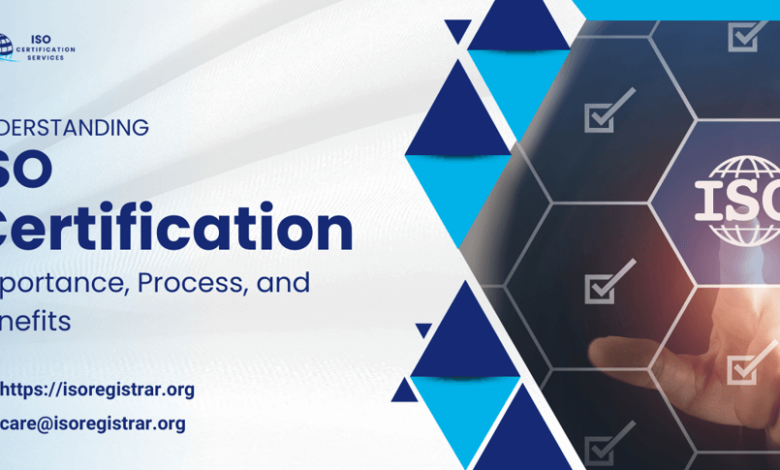Understanding the ISO Registration Certificate: Importance, Process, and Benefits

ISO (International Organization for Standardization) registration certificates are crucial for organizations aiming to establish credibility, improve operational efficiency, and enhance customer satisfaction. This guide will delve into the importance of ISO registration certificates, the process of obtaining them, and the benefits they offer to businesses and their stakeholders.
What is an ISO Registration Certificate?
An ISO registration certificate is an official document that verifies a company’s compliance with specific ISO standards. ISO is an independent, non-governmental international organization that develops standards to ensure the quality, safety, efficiency, and interoperability of products and services. These standards are designed to be universally applicable across industries, promoting consistency and best practices globally.
The most common ISO standards include:
ISO 9001: Quality Management Systems
ISO 14001: Environmental Management Systems
ISO 45001: Occupational Health and Safety Management Systems
ISO 27001: Information Security Management Systems
The Process of Obtaining an ISO Registration Certificate
The journey to ISO certification involves several key steps:
Understanding the Relevant ISO Standards:
Organizations must first identify which ISO standards are relevant to their operations. Some common standards include ISO 9001 for quality management, ISO 14001 for environmental management, ISO 27001 for information security, and ISO 45001 for occupational health and safety.
Gap Analysis and Planning:
Conducting a gap analysis helps organizations identify areas where their current practices do not meet the ISO standard requirements. This step involves a thorough review of existing processes, documentation, and systems. Based on the findings, organizations can create a detailed plan to address any deficiencies.
Implementation:
Implementing the necessary changes is the most critical phase. This may involve revising processes, training employees, and adopting new technologies. The goal is to align the organization’s operations with the requirements of the ISO standard.
Internal Audit:
Before seeking external certification, organizations should conduct an internal audit to ensure they meet the ISO requirements. This helps identify any remaining issues and provides an opportunity to make final adjustments.
Selecting a Certification Body:
Organizations must choose an accredited certification body to conduct the external audit. It is essential to select a reputable body recognized by national and international accreditation organizations.
External Audit:
The certification body conducts a thorough audit to assess the organization’s compliance with the ISO standard. This involves reviewing documentation, observing processes, and interviewing employees. If the organization meets the requirements, the certification body issues the ISO registration certificate.
Continuous Improvement and Recertification:
ISO certification is not a one-time achievement. Organizations must continually improve their processes and undergo regular surveillance audits to maintain their certification. Recertification is typically required every three years.
Benefits of ISO Registration Certificates
Achieving ISO certification offers numerous advantages for organizations, including:
Enhanced Credibility and Reputation:
ISO certification is a mark of quality and reliability recognized worldwide. It enhances an organization’s credibility with customers, partners, and stakeholders, opening doors to new business opportunities.
Improved Efficiency and Effectiveness:
Implementing ISO standards helps streamline processes, reduce waste, and improve resource management. This leads to increased operational efficiency and effectiveness, resulting in cost savings and higher productivity.
Better Risk Management:
ISO standards provide a structured approach to identifying and mitigating risks. This proactive risk management helps organizations minimize disruptions, enhance security, and ensure compliance with legal and regulatory requirements.
Read also: Digital Signature Certificates: Streamlining Government Efficiency and Security
Increased Customer Satisfaction:
By adhering to ISO standards, organizations can consistently deliver high-quality products and services that meet customer expectations. This leads to higher customer satisfaction, loyalty, and retention.
Employee Engagement and Development:
Implementing ISO standards involves training and engaging employees in continuous improvement initiatives. This fosters a culture of quality and innovation, leading to higher employee morale and development.
Market Access and Competitive Advantage:
Many markets and industries require ISO certification as a prerequisite for doing business. Having an ISO registration certificate can be a significant competitive advantage, helping organizations access new markets and differentiate themselves from competitors.
Note: Apply for ISO 45001: 2018 NON-IAF through the official portal.
Conclusion
ISO registration certificates play a vital role in helping organizations demonstrate their commitment to quality, efficiency, and continuous improvement. The rigorous process of obtaining ISO certification ensures that organizations adhere to internationally recognized standards, enhancing their credibility, operational performance, and customer satisfaction. As a result, ISO certification is a valuable asset for any organization seeking to thrive in today’s competitive global marketplace.
By understanding the importance of ISO registration certificates and the steps involved in achieving them, organizations can position themselves for long-term success and sustainability. Embracing ISO standards not only drives internal improvements but also builds trust and confidence among external stakeholders, ultimately contributing to the organization’s overall growth and prosperity.






